

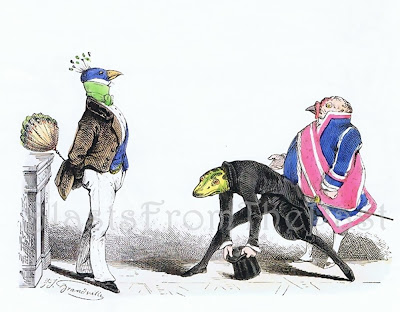





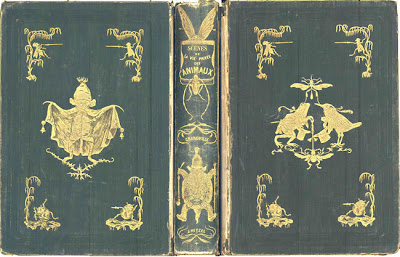


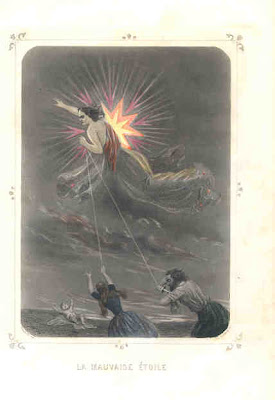
Thanks to one of my 'students' of my Illustration for Picture Books class, I have once again learned something else. This something else is J.J. Grandville. Lynda kindly let me borrow her book 'Grandville's Animals- The World's Vaudeville'. In this book are featured a collection of lithographs from two of Grandville's major books 'The Metamorphoses of the Day' (1829) and 'Scenes from the Private and Public Life of Animals' (1842).
From the introduction by Bryan Holme:
"It has been said that if it hadn't been for J.J. Grandville there would have been no John Tenniel and no Edward Lear. And if it hadn't been for the ancient Egyptian mystics who drew animal heads on human bodies, perhaps there would have been no Grandville either."
"Nothing like this had been seen before: birds, cats, dogs, elephants, tortoises-even beetles-behaving as well as looking like humans. Adding to the novelty of Methamorphoses, which became the rage in Paris, was the new lithography process by which the illustrations were printed. Clothing his animals in the fashion of the day and giving them human airs, gestures, emotions and thoughts, Grandville assigned each of his characters a role in the world's vaudeville" as Charles Blanc so aptly put it."
"Together with the Grimm brothers' collection of fairlytales, which had been published in Germany in 1812 and in England in 1823 under the title of 'Household Stories' Grandville's two books represented milestones in publishing that se the stage for a whole new trend in fairytale and animal story books."
"Grandville was to influence hundreds of illustrators. By 1850s, Charles Bennett had illustrated his bizarre Aesop's Fables, a book which could amost be taken for the work of Grandville, and George Cruikshank was drawing Grandvillesque cartoons like his 'Fellows of the Zoological Society' for The Comic Almanack. In the 1870's Walter Crane's Beast in Beauty and Wolf in Little Red Riding Hood were in the same Grandville genre. Later came Arthur Rackham, and after the turn of the century, Beatrix Potter, and later still Walt Disney and so very many other young illustrators, each depicting animals as humans in his own particular way. Until recently however, the far-reaching influence of Grandville's books was never fully recognized outside France except by artists, illustrators, and connoisseurs. "
"For professional reasons-his father also being an artist- Grandville adopted the stage name of his grandfather, who was an actor of repute. His real name was Jean-Ignace-Isidore Gerard. "
"In 1823 the family scraped enough money together to send him to Paris, where he was to study art and make his own way. Within a short four years his first illustrations, Four Seasons of the human life, were published and and - shortly thereafter, Voyage to Eternity, inspired by Holbein's series of woodcuts The Dance of Death. "While looking Grandville up I also came across his series of 'Les Etoiles' (The Stars) and 'Les Fleurs' (The Flowers). I have featured a couple of these in the images above. They are pretty unique and I am really glad to have found them! Also, here's a good blog post on Grandville at Love for Books.... and ... here's a good piece giving you a glimpse into a specific image of Grandville's and how to make sense of it. So yeah, thank you Lynda Cameron! Way to teach me something!





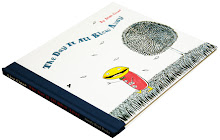
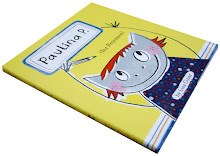
















No comments:
Post a Comment